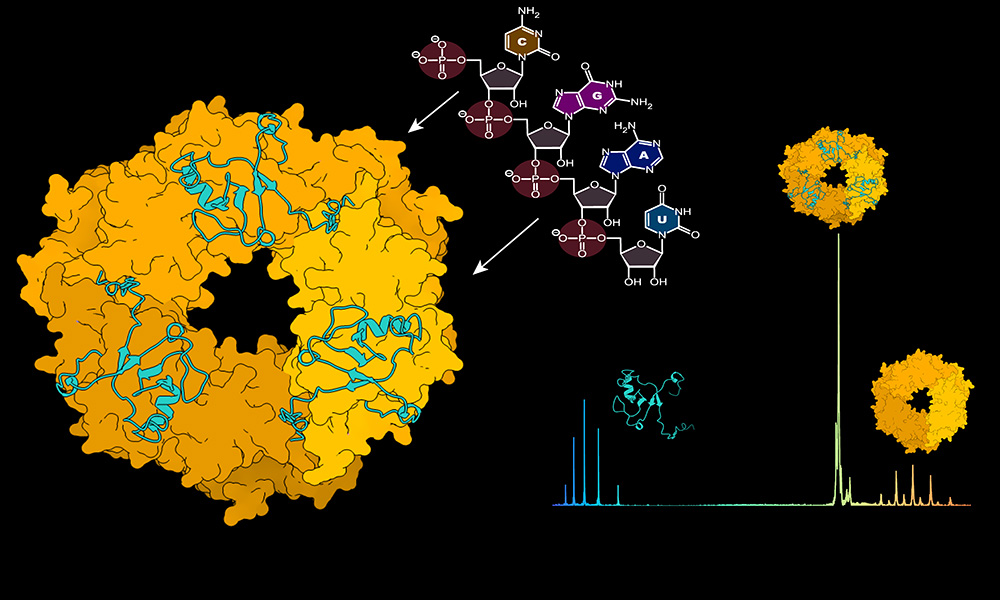RNA to Rule Them All: Critical Steps in Lassa Virus Ribonucleoparticle Assembly and Recruitment.
Journal of the American Chemical Society 17 December2023
10.1021/jacs.3c07325
Critical steps in Lassa virus ribonucleoparticle assembly and recruitment revealed

Lassa virus (LASV) is the pathogen that causes Lassa hemorrhagic fever, a disease endemic to West Africa, which causes approximately 5,000 deaths each year. The Uetrecht (DESY, LIV, Uni Siegen), Kosinski (CSSB, EMBL), and Rosenthal groups (BNITM, CSSB) have worked together to reveal RNA’s crucial role during critical steps of the Lassa virus life cycle. Their findings have recently been published in the Journal of the American Chemical Society.
In the human body, 20,000 genes produce over one million different forms of proteins. By comparison, the Lassa virus is minuscule, composed of only four proteins known as L, NP, Z and GPC.
“We are trying to understand how these four proteins can cause such serious damage to human cells,” explained Lennart Sänger, the paper’s first author. “The activities and expression of these proteins must be tightly regulated, and the proteins must communicate efficiently with one another to take on different functions.”
To protect and hide the virus from detection by the immune system, the nucleoprotein (NP) encloses the viral genome in a capsid. This capsid together with viral RNA and the L protein form ribonucleoprotein complexes (RNPs). To propagate infection, RNPs must continuously restructure themselves to enable viral genome replication and transcription. The researchers investigated the interactions between NP and viral RNA as well as the Z protein to better understand the mechanism and dynamics of RNP formation and packaging into new viral particles.
Using structural mass spectrometry, a method that acts like a molecular scale to reveal the atomic weight of molecular interactions, the researchers examined the dynamics between NP and viral RNA.
“Initially, the NP protein doesn’t exist in a composition that can bind viral RNA,” explained Charlotte Uetrecht, a CSSB group leader and expert in mass spectrometry techniques. “A change needs to occur to enable this binding, and we discovered that viral RNA can initiate this change by itself.”
The researchers identified RNA as the driver for disassembly of ring-like NP trimers into monomers that are then able to form higher-order RNA-bound NP assemblies.
The researchers also investigated NP interaction with the Z protein in more detail. To facilitate this the Kosinski group used AlphaFold to predict the NP-Z complex’s interaction site. These predictions were then verified by researchers in the laboratory.
“Using artificial intelligence enabled us to quickly identify possible interactions and also enabled us to create mutants to verify our hypothesis,” noted Jan Kosinski, group leader.
The researchers were ultimately able to demonstrate that while NP binds Z independently of the presence of RNA, this interaction is pH-dependent.
“Overall, these findings help improve our understanding of RNP assembly, recruitment, and release in Lassa virus,” explained Maria Rosenthal, a Lassa virus expert at the Bernhard Nocht Institute for Tropical Medicine and a CSSB associate member.
In West Africa, 186 million people are predicted to be at risk of developing Lassa virus infections by 2030, and the World Health Organization recognises Lassa virus as a dangerous, yet understudied pathogen.
“Understanding how Lassa virus functions may ultimately enable us to develop molecules that could inhibit replication of this virus and treat Lassa fever,” Rosenthal noted.
This study adds to previous work on the Lassa virus conducted by the Rosenthal Group and the Cusack Group at EMBL Grenoble during their several years of collaboration.
This work aligns with the goals of the EMBL’s Infection Biology transversal theme, which is part of the EMBL Programme ‘Molecules to Ecosystems’, and which aims to contribute to research on the biology and mechanisms of infection, as well as on diagnostics and treatment of infectious diseases.
This article has been adapted from a news article by the Centre for Structural Systems Biology (CSSB). Find the original story at the CSSB website here.
Journal of the American Chemical Society 17 December2023
10.1021/jacs.3c07325